Unified Endpoint Management Market Size and Share
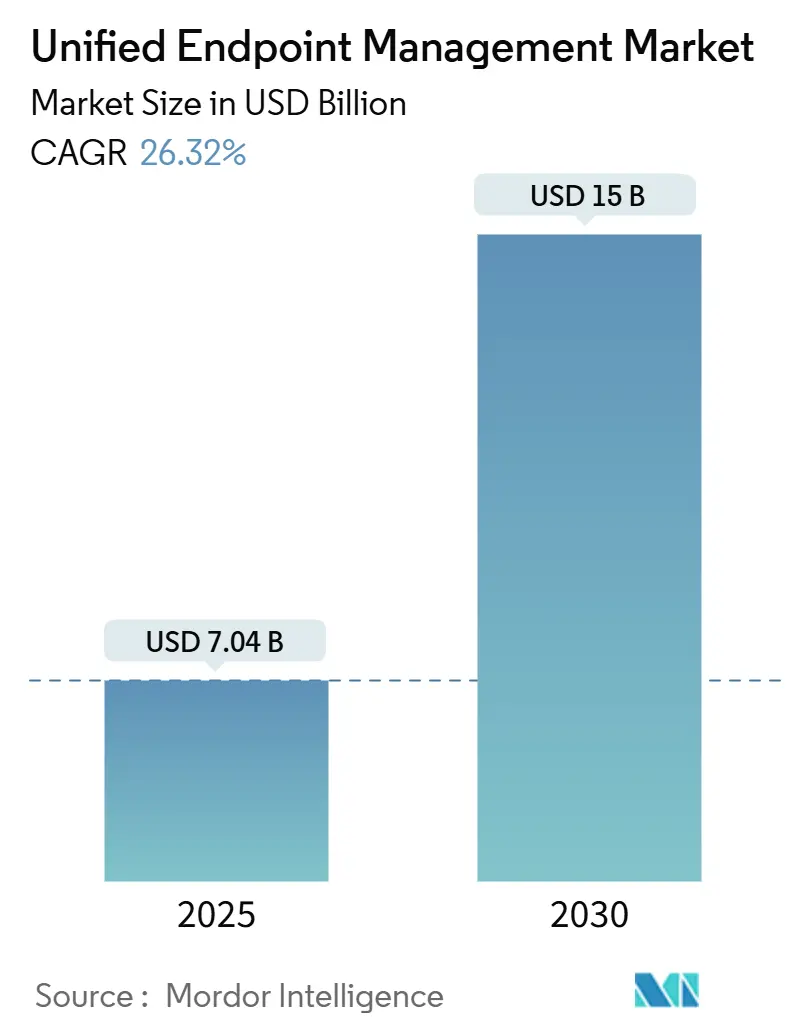
Unified Endpoint Management Market Analysis by Mordor Intelligence
The Unified Endpoint Management market is valued at USD 7.04 billion in 2025 and is forecast to reach USD 15 billion by 2030, advancing at a 26.32% CAGR. Demand is expanding as organisations secure laptops, mobiles, rugged IoT sensors and AI-enabled applications inside hybrid workplaces. Convergence between operational-technology and information-technology stacks is steering buyers toward integrated platforms delivered by hyperscale clouds such as Microsoft Azure, where revenue is advancing 33% through AI-centric services[1]Microsoft News Center, “Azure AI momentum boosts cloud revenue,” microsoft.com. Public-cloud adoption supports policy orchestration, real-time identity control and predictive analytics that replace siloed point tools. Services growth mirrors a talent shortage in cybersecurity and automation skills, while verticals such as healthcare, manufacturing and logistics adopt digital employee experience tooling to reduce downtime. Asia-Pacific’s rapid industrial digitalisation, alongside regulatory pushes for zero trust in North America and Europe, broadens the geographic opportunity for vendors that can meet data-sovereignty requirements and deliver consistent security outcomes.
Key Report Takeaways
- By component, Solutions held 67.40% Unified Endpoint Management market share in 2024, whereas Services expand at a 23.30% CAGR to 2030.
- By deployment mode, Cloud accounted for 60.90% of the Unified Endpoint Management market size in 2024 and is projected to advance at a 26.10% CAGR through 2030.
- By organisation size, Large Enterprises dominated with 72.35% revenue in 2024; Small and Medium Enterprises record the fastest 25.60% CAGR to 2030.
- By end-user industry, Information Technology and Telecommunications led with 27% revenue in 2024; Healthcare and Life Sciences is set to grow at a 30.80% CAGR.
- By geography, North America captured 40.60% revenue in 2024, while Asia-Pacific posts the highest 16.90% CAGR.
Global Unified Endpoint Management Market Trends and Insights
Drivers Impact Analysis
| Driver | (~) % Impact on CAGR Forecast | Geographic Relevance | Impact Timeline |
|---|---|---|---|
| Hybrid-work and BYOD acceleration | +6.8% | Global, highest in North America and Europe | Medium term (2-4 years) |
| Escalating cyber-threat surface and zero-trust roll-outs | +7.2% | Global, critical in Asia-Pacific and North America | Short term (≤ 2 years) |
| Platform convergence of endpoint, identity and access management | +5.4% | North America and Europe leading | Long term (≥ 4 years) |
| ESG-driven demand for device-level carbon analytics | +2.1% | Europe and North America | Long term (≥ 4 years) |
| AI-based Digital Employee Experience optimisation | +4.7% | Global, early in North America | Medium term (2-4 years) |
| Frontline/IoT device explosion in warehousing and field ops | +3.9% | Manufacturing-heavy regions | Medium term (2-4 years) |
| Source: Mordor Intelligence | |||
Hybrid-Work and BYOD Acceleration
Enterprises now provision and secure three to four times more device categories than in 2020, compelling Unified Endpoint Management market solutions to move beyond basic control toward context-aware orchestration that supports productivity anywhere. Microsoft Intune’s AI additions illustrate how predictive analytics remove VPN bottlenecks and automate conditional-access decisions. Containerisation that separates business and personal data has become standard, demonstrated by Phoenix Children’s Hospital, which automates identity workflows to protect patient records while maintaining clinician mobility. Vendors combining seamless user experience with rigorous compliance win contracts in sectors where regulation intersects with mobility.
Escalating Cyber-Threat Surface and Zero-Trust Roll-Outs
BlackBerry logged 600,000 cyberattacks on critical infrastructure in Q3 2024, nearly half targeting finance, underscoring the scale of endpoint-centric risk. Security teams therefore adopt zero-trust architectures that authenticate users and devices continuously. Partnerships such as Zscaler with CrowdStrike allow policy engines to query device posture before granting resource access. Manufacturers are vulnerable; Armis finds 66% have experienced IoT-related incidents, driving demand for unified visibility across shop-floor assets and corporate laptops.
Platform Convergence of Endpoint, Identity and Access Management
Unified Endpoint Management market platforms increasingly embed identity and access control, dissolving former boundaries. Beyond Identity integrates passwordless authentication with multiple security stacks, positioning UEM as an orchestration layer for consistent policy enforcement. Microsoft combines Intune with 365 security functions, while IBM positions its UEM within a USD 14.5 billion hybrid-cloud and automation portfolio that recorded 7% software growth in Q1 2025[2]IBM Investor Relations, “Q1 2025 Earnings Presentation,” ibm.com. Buyers gravitate toward broad suites that simplify licensing and reduce integration risk.
AI-Based Digital Employee Experience (DEX) Optimizations
Machine learning turns endpoint data into foresight, letting IT resolve issues before users notice. Generative AI within UEM tools writes remediation scripts and boosts help-desk productivity, lowering skills barriers for midsize enterprises. Nexthink’s analytics connect device health to sentiment scores, revealing correlations between boot time and employee churn. Organisations that transform telemetry into business-level metrics can justify investment by proving direct productivity gains.
Restraint Impact Analysis
| Restraint | (~) % Impact on CAGR Forecast | Geographic Relevance | Impact Timeline |
|---|---|---|---|
| Data-sovereignty and privacy compliance hurdles | -3.2% | Europe and Asia-Pacific | Short term (≤ 2 years) |
| High migration and integration cost of legacy estates | -2.8% | Global, large enterprises | Medium term (2-4 years) |
| Post Broadcom-VMware divestiture procurement uncertainty | -4.1% | Global, highest in North America and Europe | Short term (≤ 2 years) |
| Talent gap in low-code automation and scripting for UEM | -2.3% | Global, acute in Asia-Pacific | Long term (≥ 4 years) |
| Source: Mordor Intelligence | |||
Data-Sovereignty and Privacy Compliance Hurdles
Strict regional rules oblige multinational firms to localise control planes and audit data flows, delaying cloud roll-outs. BlackBerry earned German BSI clearance to manage Apple devices on classified networks, showing how vendor certification unlocks regulated accounts. Cisco’s launch of European data warehouses for its Umbrella security stack highlights supplier investment needed to meet these mandates. Splitting global estates into regional instances raises cost and complicates policy harmonisation.
Post Broadcom-VMware Divestiture Procurement Uncertainty
Broadcom’s USD 69 billion VMware acquisition and the subsequent sale of the end-user computing division to KKR, now rebranded Omnissa, upended roadmaps for organisations that standardised on Workspace ONE. Licence hikes and SKU rationalisation force buyers to reassess long-term commitments, extending procurement cycles. Channel restructuring that removed thousands of smaller resellers amplifies risk for customers dependent on historical partners. Opportunity arises for challenger vendors, yet momentum stalls as large enterprises pause migrations to track evolving terms.
Segment Analysis
By Component: Services Acceleration Drives Market Evolution
Solutions retained 67.40% revenue in 2024, yet Services expand fastest at 23.30% CAGR, signalling a pivot toward outcome-focused purchasing. Healthcare and manufacturing customers contract integration partners to mesh UEM with electronic health-record systems or industrial gateways. Managed service providers harness AI to deliver proactive remediation that lowers total cost of ownership. The skills gap of nearly 700,000 US cybersecurity vacancies elevates demand for outsourced expertise, boosting revenue for consultancies and value-added resellers. Service contracts increasingly bundle continuous optimisation, demonstrating how consultative engagements influence platform selection and lock-in.
The Unified Endpoint Management market rewards vendors that package advisory, migration and automation into tiered offerings. Providers introduce consumption-based pricing so clients scale seats in line with headcount swings. AI chatbots embedded in service desks triage incidents, freeing scarce engineers for strategic projects. Looking ahead, co-managed models, where internal staff run policy while partners maintain infrastructure, will widen as midmarket firms adopt UEM without hiring full-time specialists.
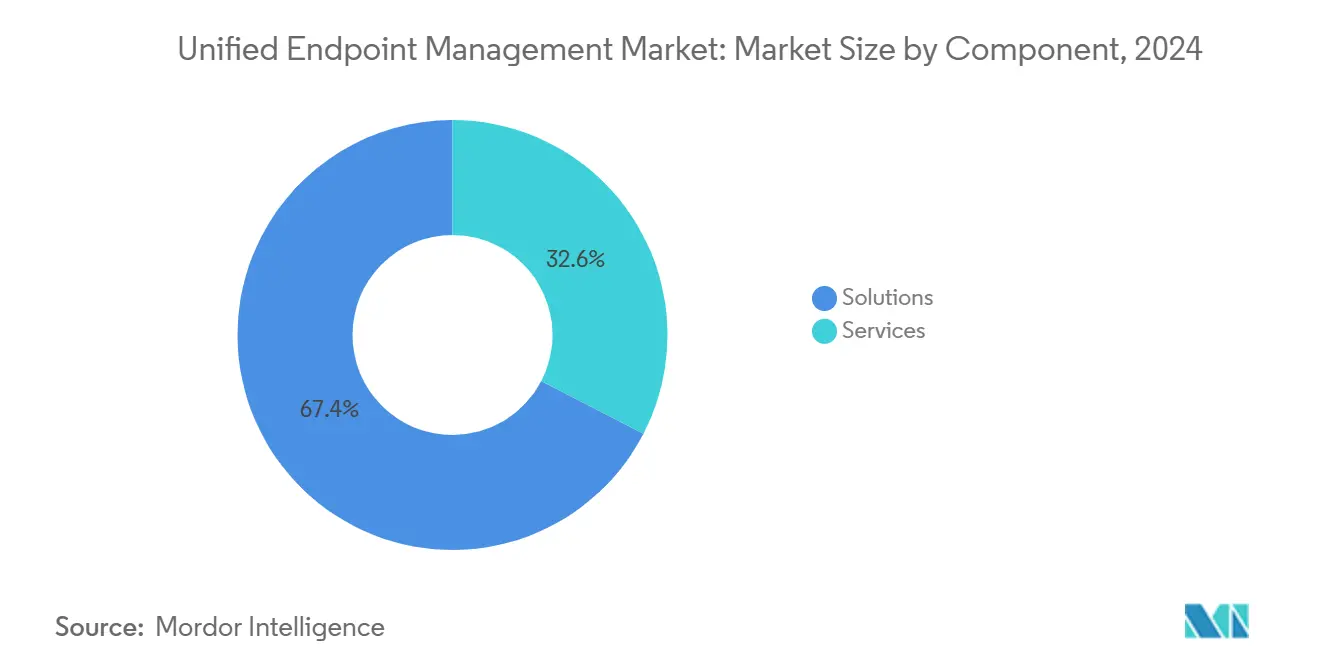
By Deployment Mode: Cloud Dominance Accelerates Digital Transformation
loud commanded 60.90% revenue in 2024 and is tracking a 26.10% CAGR as organisations prioritise elasticity and rapid feature uptake. Public-cloud platforms deliver embedded analytics, global edge presence and near-instantaneous patch availability. Microsoft’s 20-22% overall cloud revenue rise, largely powered by AI workloads on Azure, proves hyperscale scale economics. The Unified Endpoint Management market size for cloud solutions is projected to exceed USD 9 billion by 2030, representing more than 60% of total new spend.
On-premises installations persist in defence, utilities and government segments where air-gap or dark-site constraints apply. Vendors meet those needs through appliance form factors and sovereign-cloud regions. Hybrid architectures therefore dominate transition strategies, allowing policy consistency while respecting localisation regulations. Suppliers able to offer identical management consoles across hosting models gain an advantage as buyers seek flexibility to relocate workloads.
By Organization Size: SME Adoption Accelerates Through Simplified Solutions
Large Enterprises supplied 72.35% revenue in 2024, yet Small and Medium Enterprises are growing 25.60% annually, catalysed by software-as-a-service price points and no-code onboarding. SMEs value subscription models that avoid capital budgets and provide security parity with bigger competitors. India hosts 75 million SMEs contributing 36% of manufacturing output; their cloud-first approach makes them prime candidates for automated UEM delivered via regional data centres.
The Unified Endpoint Management market benefits from vendors embedding guided setup, auto-discovery and AI-generated policy templates that compress deployment times from weeks to hours. Among large enterprises, expansion now centres on integrating operational-technology endpoints and remote kiosks, generating upsell potential through advanced analytics. Low-code scripting tools narrow the gap between enterprise and SME capability, but the labour shortage complicates in-house operations, reinforcing demand for managed offerings.
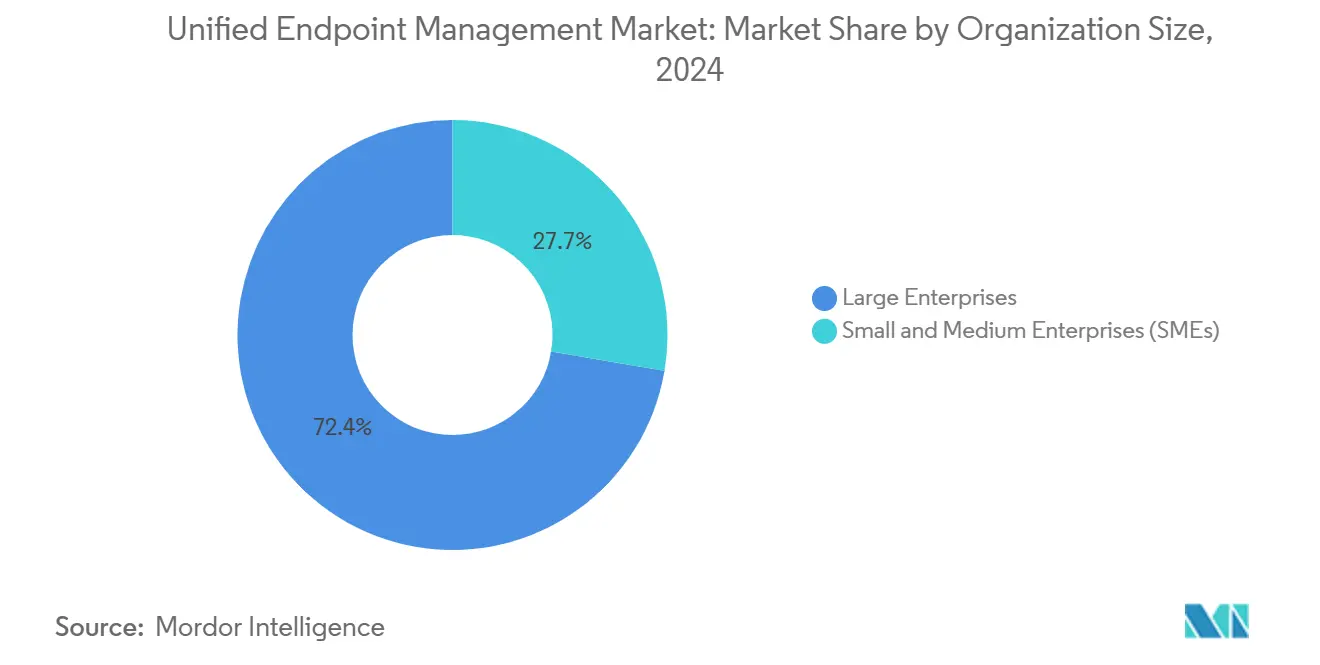
By End-User Industry: Healthcare Leads Digital Transformation
Information Technology and Telecommunications retained 27% revenue in 2024 due to early adoption and continuous refresh cycles. Healthcare and Life Sciences post the strongest 30.80% CAGR as hospitals connect infusion pumps, imaging systems and clinician tablets. BayCare Health System manages 33,000 devices through Palo Alto Networks IoT Security, highlighting the critical nature of real-time visibility. The Unified Endpoint Management market size for healthcare endpoints is projected to grow at a CAGR of 30.80% by 2030 as regulatory frameworks mandate auditable control.
Manufacturing accelerates through Industry 4.0 programmes that marry shop-floor robotics with corporate applications, demanding unified governance of mixed traffic. Financial services expand zero-trust roll-outs to combat identity-based fraud, while public-sector agencies seek platforms with government-grade certifications. Vendors tailoring compliance packs and verticalised dashboards capture sector-specific opportunities.
Geography Analysis
North America generated 40.60% revenue in 2024, anchored by mature cloud adoption and stringent cyber-insurance standards that push enterprises toward integrated endpoint and identity control. Federal guidelines on zero-trust architectures further stimulate demand, and vendor ecosystems benefit from a deep skill base that accelerates deployment projects. Services revenue is particularly strong as Fortune 100 firms consolidate overlapping tools following M&A.
Europe follows with focused growth fuelled by data-sovereignty mandates such as GDPR and local cloud certifications. Vendors operating regional data centres and member-state security clearances gain preference. ESG reporting requirements add further complexity, spurring interest in device-level energy analytics within the Unified Endpoint Management market. Suppliers that deliver carbon-emission dashboards integrated with asset inventory appeal to sustainability initiatives.
Asia-Pacific, advancing at 16.90% CAGR, is the fastest expanding territory. China, Japan and India invest in smart-manufacturing and 5G-centric workflows that multiply edge endpoints. Japanese majors like Suzuki deploy Azure OpenAI services to unify factory and office systems. Australia and Singapore enact critical-infrastructure statutes that enforce rigorous endpoint monitoring. The region’s widespread mobile-first business culture, combined with fewer legacy estates, allows greenfield adoption of cloud-native platforms that leapfrog earlier client-server models.
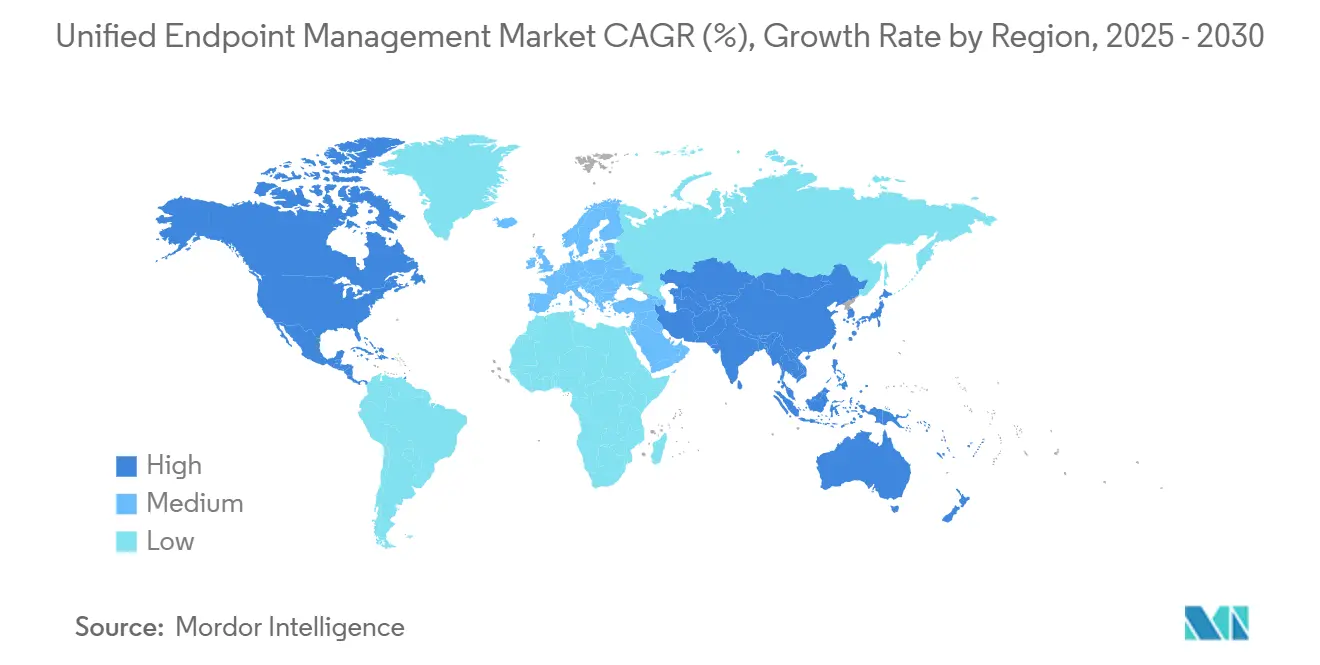
Competitive Landscape
The market displays moderate consolidation around platform vendors with integrated security and productivity stacks. Microsoft leverages its Microsoft 365 base, embedding Intune and Defender to lock accounts into a single licence framework. IBM generated USD 6 billion in generative-AI revenue during Q1 2025, showcasing its pivot toward automation suites that incorporate UEM. Alphabet, Cisco and VMware (Omnissa) compete on secure access edge services and multicloud orchestration.
Broadcom’s takeover of VMware disrupted price stability, motivating customers to evaluate alternatives such as Ivanti, Jamf for Apple fleets and 42Gears in rugged environments. BlackBerry secured BSI clearance for German government deployments, using certifications to defend niche high-security segments[3]BlackBerry Limited, “Cybersecurity Threat Report Q3 2024,” blackberry.com. TeamViewer’s acquisition of 1E extends into digital employee experience, while CyberArk’s USD 1.54 billion Venafi purchase ties machine identity with endpoint posture. Competitive advantage now hinges on AI-driven remediation, zero-trust integration and energy analytics rather than traditional mobile-device management features.
Strategic alliances proliferate: Zscaler integrates posture signals from CrowdStrike, and Palo Alto Networks partners with ServiceNow for automated incident response. Vendor roadmaps focus on low-code policy modelling and generative AI assistants to ease administration. Pricing innovation such as outcome-based SLAs emerges as buyers scrutinise total cost against measurable productivity gains.
Unified Endpoint Management Industry Leaders
-
IBM Corporation
-
Microsoft Corporation
-
Broadcom Inc.
-
Ivanti Inc.
-
Citrix Systems Inc.
- *Disclaimer: Major Players sorted in no particular order
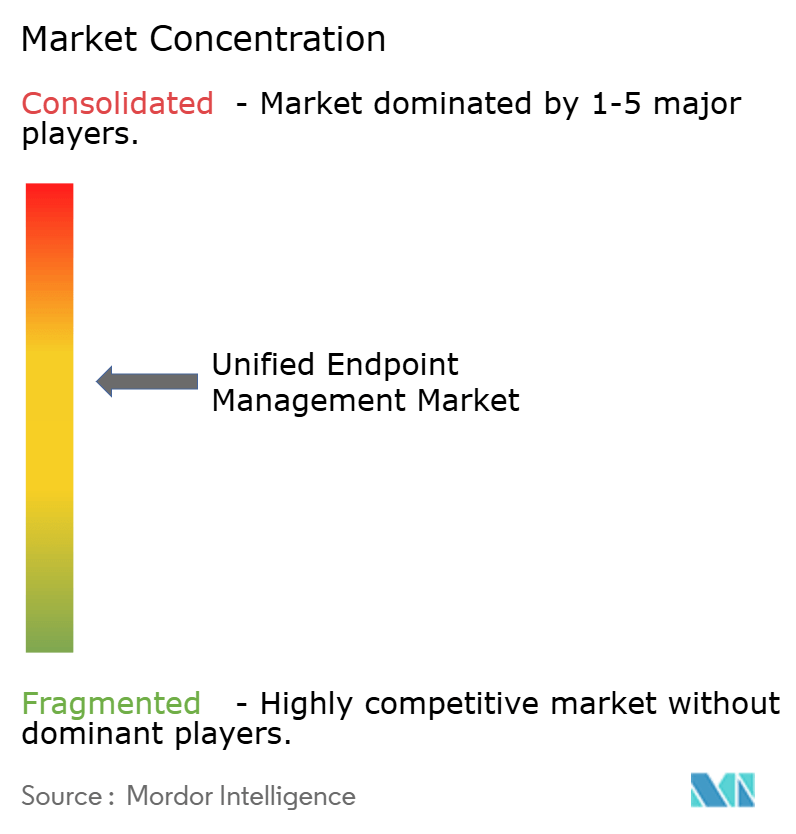
Recent Industry Developments
- May 2025: Ivanti raised USD 350 million, extending debt to 2029 to fund Ivanti Neurons and Unified Endpoint Management solutions.
- May 2025: JumpCloud purchased VaultOne to enrich privileged-access capabilities across its unified identity, device and access platform.
- May 2025: IBM realigned software and consulting categories to emphasise Hybrid Cloud, Automation and Data opportunities.
- February 2025: TeamViewer acquired 1E, expanding digital-employee-experience functions within the Unified Endpoint Management market.
Research Methodology Framework and Report Scope
Market Definitions and Key Coverage
Our study defines the unified endpoint management market as every software platform and related service that lets an organization enroll, configure, monitor, and secure laptops, desktops, smartphones, rugged handhelds, wearables, and IoT endpoints from one console. According to Mordor Intelligence, the scope counts perpetual licenses, SaaS subscriptions, and managed services purchased by commercial, government, and education customers worldwide.
Scope Exclusions: Stand-alone mobile-device management tools that do not extend policy enforcement to PCs or IoT devices are excluded.
Segmentation Overview
- By Component
- Solutions
- Services
- By Deployment Mode
- On-premise
- Cloud
- By Organization Size
- Large Enterprises
- Small and Medium Enterprises (SMEs)
- By End-User Industry
- Banking, Financial Services and Insurance (BFSI)
- Government and Public Sector
- Information Technology and Telecommunications
- Healthcare and Life Sciences
- Manufacturing and Industrial
- Retail and E-Commerce
- Others (Energy, Education, etc.)
- By Geography
- North America
- United States
- Canada
- Mexico
- South America
- Brazil
- Argentina
- Rest of South America
- Europe
- United Kingdom
- Germany
- France
- Italy
- Spain
- Nordics
- Rest of Europe
- Asia-Pacific
- China
- India
- Japan
- South Korea
- ASEAN
- Australia
- New Zealand
- Rest of Asia-Pacific
- Middle East and Africa
- Middle East
- Saudi Arabia
- United Arab Emirates
- Turkey
- Rest of Middle East
- Africa
- South Africa
- Egypt
- Nigeria
- Rest of Africa
- Middle East
- North America
Detailed Research Methodology and Data Validation
Primary Research
Mordor analysts interview endpoint security architects, procurement leads, and channel partners across North America, Europe, and Asia-Pacific. These conversations clarify real-world device mixes, license renewal behavior, and regional compliance triggers, helping us validate secondary signals and fine-tune key assumptions.
Desk Research
We collect baseline metrics from authoritative, open sources such as NIST zero-trust guidelines, ENISA threat bulletins, International Telecommunication Union device penetration tables, FCC equipment authorizations, Cloud Security Alliance papers, and IEEE Access studies on enterprise mobility. Annual reports, 10-Ks, investor decks, and reputable press provide revenue splits, subscription counts, and deployment anecdotes that sharpen our supply-side view.
Paid resources are tapped judiciously; D&B Hoovers gives company financials, while Dow Jones Factiva flags material announcements that could swing adoption or pricing. The sources listed here illustrate our approach and are not exhaustive.
Market-Sizing & Forecasting
We construct a top-down demand pool using active workforce counts, average devices per employee, and BYOD penetration, which are then multiplied by prevailing subscription ASPs. Supplier roll-ups and selective channel checks act as a bottom-up reasonability screen. Variables such as hybrid-work adoption, OS life-cycle roadmaps, cybersecurity spending indices, regulatory mandates, and endpoint refresh cycles feed a multivariate regression that projects values through 2030. Gaps in source granularity are bridged with analog benchmarks from similar software categories and confirmed with expert feedback.
Data Validation & Update Cycle
Modeled outputs pass variance checks against independent device shipment tallies and disclosed vendor revenue. Senior analysts review anomalies before sign-off. We refresh each dataset every twelve months and trigger interim updates when material events, like a major cyber incident or licensing model change, occur.
Why Mordor's Unified Endpoint Management Baseline Commands Reliability
Published market estimates often diverge because firms choose different endpoint buckets, revenue definitions, refresh cadences, and currency conversions. Our disciplined scope selection and annual refresh keep the baseline tightly aligned with how buyers actually procure UEM today.
Key gap drivers include whether managed-service fees are counted, how aggressively future device ratios are assumed, and if cloud upsell premiums are applied. By tying every assumption to observable metrics and expert consensus, we minimize bias from blanket growth multipliers or legacy exchange rates.
Benchmark comparison
| Market Size | Anonymized source | Primary gap driver |
|---|---|---|
| USD 7.04 billion (2025) | Mordor Intelligence | - |
| USD 5.29 billion (2023) | Regional Consultancy A | Excludes managed-service revenue; single 2022 FX rate |
| USD 6.80 billion (2025) | Global Consultancy B | Uses fixed 18 % growth multiplier; no device-mix adjustment |
| USD 5.63 billion (2024) | Industry Association C | Counts software licenses only; omits SaaS renewals |
These comparisons show that, while others provide useful snapshots, Mordor's balanced mix of verified variables, periodic reviews, and transparent assumptions delivers the most dependable baseline for strategic planning.
Key Questions Answered in the Report
What is the value of the Unified Endpoint Management market in 2025?
The market stands at USD 7.04 billion in 2025 and is projected to grow rapidly through 2030.
How fast is the Unified Endpoint Management market expected to expand?
Revenue is forecast to rise at a 26.32% CAGR, reaching USD 15 billion by 2030.
Why are enterprises moving Unified Endpoint Management workloads to the cloud?
Cloud platforms offer scalable AI-driven analytics, faster feature delivery and lower infrastructure overhead, helping organisations manage diverse devices under hybrid-work models.
Which end-user industry is forecast to grow the quickest?
Healthcare and Life Sciences lead with a 30.80% CAGR owing to strict regulatory demands and the surge of connected medical devices.
What is the primary driver behind current buying decisions?
Hybrid-work and BYOD adoption, which requires managing three to four times more device types than before 2020, is the strongest catalyst for new deployments.
Page last updated on:



